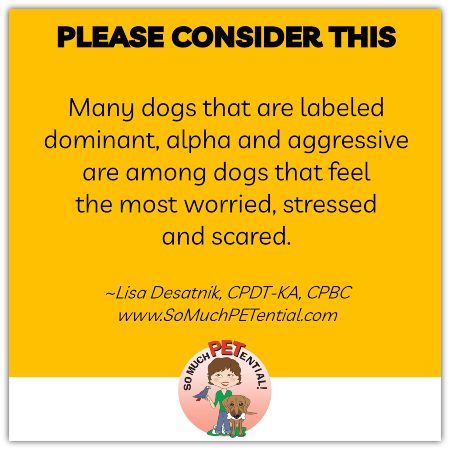The dominance and alpha theories in dog training are very much still out there. From pet owners, I may hear things like, “my dog thinks he is the alpha in our house” or “I need to be better at teaching my dog who is boss.” Even if those words are not used, I often hear about people forcing their dog to do things or taking things from their pet. It is my hope that this post will encourage a different way of looking at your relationship with your pet.
Origins Of The Alpha Dog Theory
 The alpha dog theory stems back to the 1930s and 1940s, from research conducted by Swiss animal behaviorist Rudolph Schenkel. He observed captive wolves and extrapolated their behavior to that of wild wolves. “Captive’ is a key word. In a captured environment, wolves were seen fighting, grabbing others by the neck or throat. Subservient wolves would roll over and show their bellies, which was seen as a sign of submitting to the alpha.
The alpha dog theory stems back to the 1930s and 1940s, from research conducted by Swiss animal behaviorist Rudolph Schenkel. He observed captive wolves and extrapolated their behavior to that of wild wolves. “Captive’ is a key word. In a captured environment, wolves were seen fighting, grabbing others by the neck or throat. Subservient wolves would roll over and show their bellies, which was seen as a sign of submitting to the alpha.
Later, these strategies began to be used by dog trainers and pet owners. A trainer who had a popular television show for years would advocate for and demonstrate this as a means of having a better-behaved dog.
However, other behaviorists saw a big flaw in that research. Schenkel did not observe wolves in natural settings. He studied wolves from foreign packs in false, sterile environments with limited space, resources and no appropriate outlets for energy and other instincts. “It would be like studying a group of people in prison and assuming their behavior was accurately reflecting typical suburban family dynamics,” wrote Debra Horwitz, DVM, DACVB & Gary Landsberg, DVM, DACVB, DECAWBM in an article on VCA Animal Hospitals.
Research of wolves in their natural habitat shows different behaviors. In the wild, wolf packs have been found to be similarly organized to human families. A pack consists of a mated pair and their offspring of the past one to three years. Sometimes two or three families may group together. They rely on each other for survival. Therefore, aggression between them would inhibit the pack’s survival. Social hierarchies do exist but they are not related to aggression as it has been referred to in popular culture.
- David Mech is senior research scientist at the U.S. Geological Survey and an adjunct professor at the University of Minnesota. He has researched wolves since 1958; and is also the founder of the International Wolf Center and is the vice-chair of its board of directors.He wrote, we should “once and for all end the outmoded view of the wolf pack as an aggressive assortment of wolves consistently competing with each other to take over the pack.” (Mech, 2008)
I think about the impact of that dominance and alpha belief as it pertains to our pets, and our relationship to our pets. Research has shown that dogs trained using aversive strategies show more stress signals and avoidance behaviors. Some dogs may shut down, move away or make themselves smaller while others may make themselves bigger, growl, snarl or worse.
This is something to think about. Many cases of dog aggression, whether to people or other dogs, are fear based. Aggressive behaviors are distance seeking behaviors. They are exhibited when a dog does not feel safe. In other words, many dogs that are labeled dominant, alpha and aggressive are among dogs that feel the most worried, stressed, and scared.
Focusing Instead On A Humane Approach To Dog Training
Today we have so much more knowledge. Today, I am among so many other trainers and behaviorists around the world who are committed to the Least Invasive, Minimally Aversive training (LIMA training). We recognize that a pet’s behavior is motivated by a variety of factors including genetics, medical issues, past history, socialization, fear, and basic needs. Our focus is on teaching the learner what we want the animal TO DO as much as possible rather than putting the emphasis on teaching the learner to avoid aversives. We use scientifically based principles such as operant and classical conditioning, positive reinforcement, systematic desensitization and counter-conditioning to help animals have better quality of life and stronger relationships with their people.







